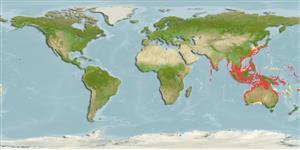Common names from other countries
Environment: milieu / climate zone / depth range / distribution range
Ecologie
; brakwater; diepteverspreiding 8 - 95 m (Ref. 8), usually 20 - 60 m (Ref. 409). Tropical; 36°N - 35°S, 72°E - 165°W
Indo-West Pacific.
Length at first maturity / Size / Gewicht / Leeftijd
Maturity: Lm ?, range 4 - ? cm Max length : 15.4 cm BL mannelijk/geslacht niet bekend; (Ref. 409); 18.9 cm BL (female); Maximaal gepubliceerd gewicht: 18.00 g (Ref. 116487)
Maximum carapace length: 3.5 cm (male); 4.2 cm (female) (Ref. 8). Common body length: 7.0 to 14.0 cm (Ref. 409). Minimum depth range from Ref. 111048. Subtidal (Ref. 106854). Found mainly in turbid waters down to a depth of 95 m over bottoms of mud, sandy-mud or silt. Juveniles are found in estuaries and backwaters, also in seagrass beds, mangrove banks, mud flats, and open channels (Ref. 8) while adults are found in deeper waters (Ref. 10). Juveniles from a riverine mangrove are likely to obtain nutrition from phytoplankton and possibly epiphytic algae than from mangrove leaves or detritus (Ref. 105141). Omnivore (Ref. 116259).
Members of the order Decapoda are mostly gonochoric. Mating behavior: Precopulatory courtship ritual is common (through olfactory and tactile cues); usually indirect sperm transfer.
Holthuis, L.B. 1980. (Ref. 8)
Status op de Rode Lijst van het IUCN (Ref. 130435)
Status bij CITES (Ref. 108899)
Not Evaluated
Not Evaluated
Gebruik door de mens
Visserij: van groot commercieel belang; aas: occasionally
FAO - Aquacultuur: production; | FishSource | Sea Around Us
Tools
Internet-bronnen
Estimates based on models
Preferred temperature
(Ref.
115969): 24.2 - 29.1, mean 28.1 (based on 1590 cells).
Weerstandsvermogen
Hoog, minimale populatieverdubbelingstijd minder dan 15 maanden (K=1.49-1.52).
Kwetsbaarheid
Low vulnerability (10 of 100).
